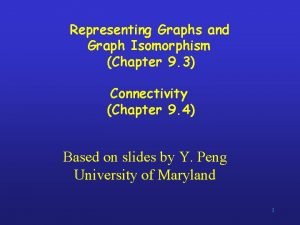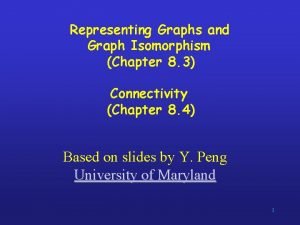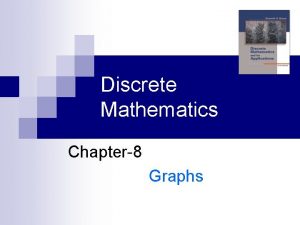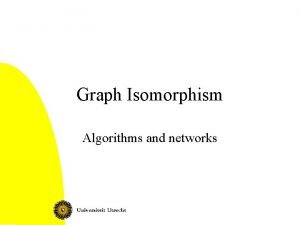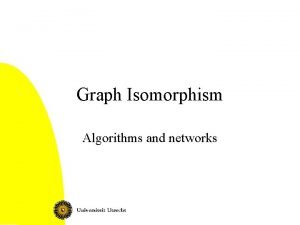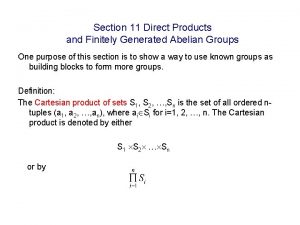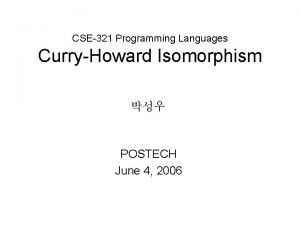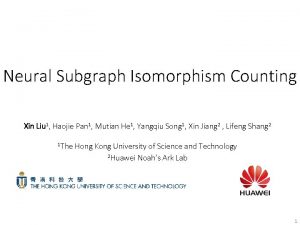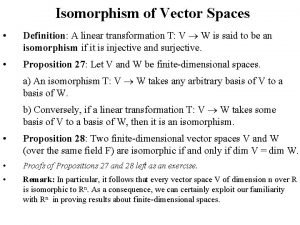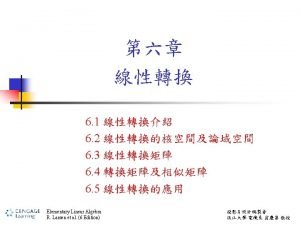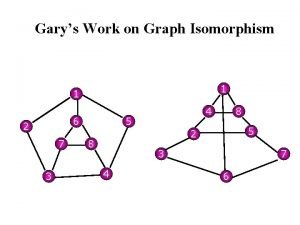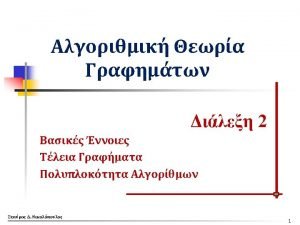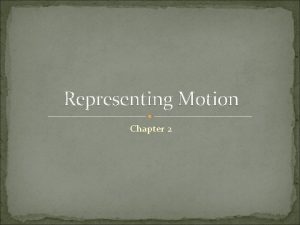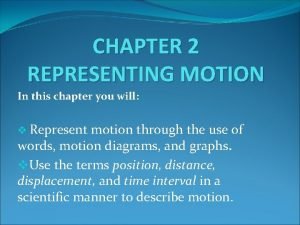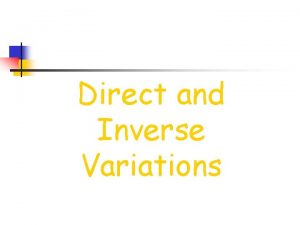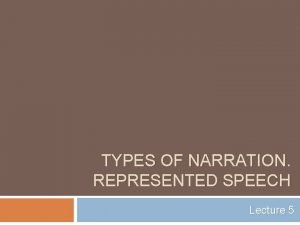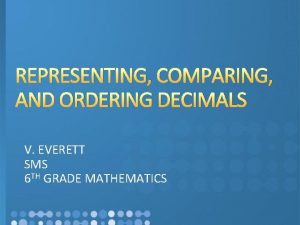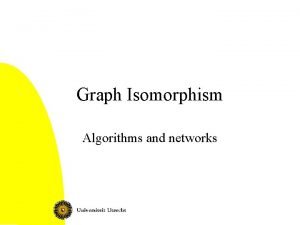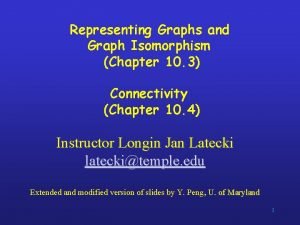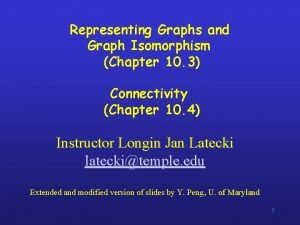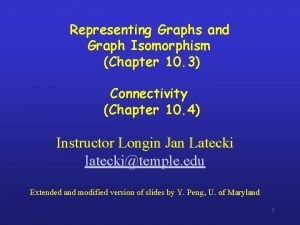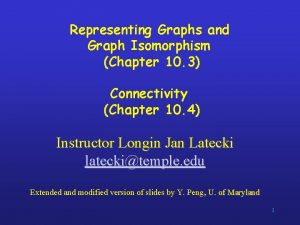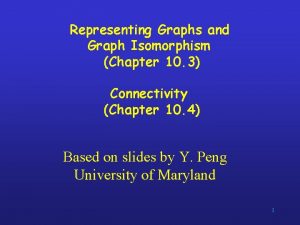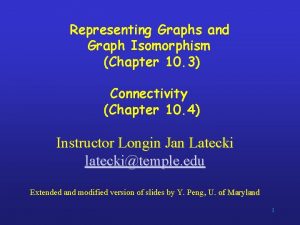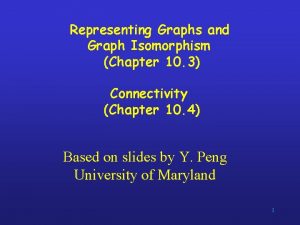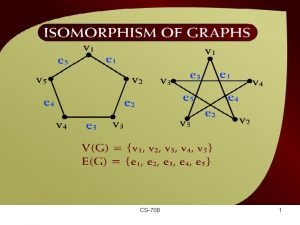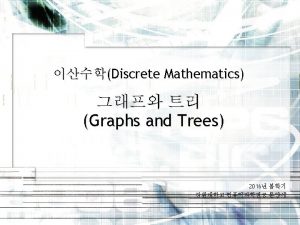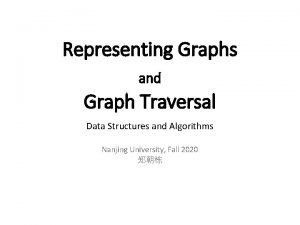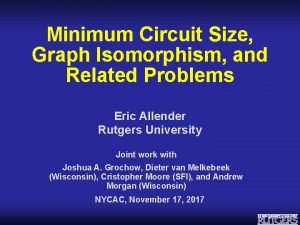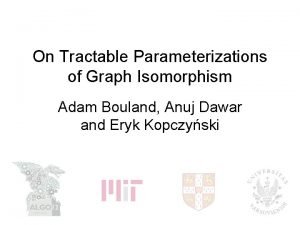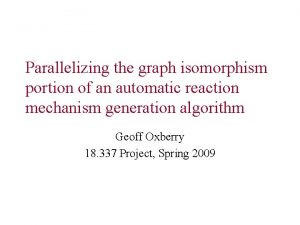Representing Graphs and Graph Isomorphism Chapter 8 3

























- Slides: 25

Representing Graphs and Graph Isomorphism (Chapter 8. 3) Connectivity (Chapter 8. 4) Based on slides by Y. Peng University of Maryland 1

Representing Graphs a d b d c Adjacent Vertex Vertices a b, c, d b a, d c a, d d a, b, c a b c Initial Vertex a b c d Terminal Vertices c a a, b, c 2

Representing Graphs Definition: Let G = (V, E) be a simple graph with |V| = n. Suppose that the vertices of G are listed in arbitrary order as v 1, v 2, …, vn. The adjacency matrix A (or AG) of G, with respect to this listing of the vertices, is the n n zero-one matrix with 1 as its (i, j) entry when vi and vj are adjacent, and 0 otherwise. In other words, for an adjacency matrix A = [aij], aij = 1 aij = 0 if {vi, vj} is an edge of G, otherwise. 3

Representing Graphs Example: What is the adjacency matrix AG for the following graph G based on the order of vertices a, b, c, d ? a d b c Solution: Note: Adjacency matrices of undirected graphs are always symmetric. 4

Representing Graphs Definition: Let G = (V, E) be an undirected graph with |V| = n. Suppose that the vertices and edges of G are listed in arbitrary order as v 1, v 2, …, vn and e 1, e 2, …, em, respectively. The incidence matrix of G with respect to this listing of the vertices and edges is the n m zeroone matrix with 1 as its (i, j) entry when edge ej is incident with vi, and 0 otherwise. In other words, for an incidence matrix M = [mij], mij = 1 mij = 0 if edge ej is incident with vi otherwise. 5

Representing Graphs Example: What is the incidence matrix M for the following graph G based on the order of vertices a, b, c, d and edges 1, 2, 3, 4, 5, 6? Solution: a 2 d 1 3 4 b 5 c 6 Note: Incidence matrices of directed graphs contain two 1 s per column for edges connecting two vertices and one 1 per column for loops. 6

Isomorphism of Graphs Definition: The simple graphs G 1 = (V 1, E 1) and G 2 = (V 2, E 2) are isomorphic if there is a bijection (an one-to-one and onto function) f from V 1 to V 2 with the property that a and b are adjacent in G 1 if and only if f(a) and f(b) are adjacent in G 2, for all a and b in V 1. Such a function f is called an isomorphism. In other words, G 1 and G 2 are isomorphic if their vertices can be ordered in such a way that the adjacency matrices MG 1 and MG 2 are identical. 7

Isomorphism of Graphs From a visual standpoint, G 1 and G 2 are isomorphic if they can be arranged in such a way that their displays are identical (of course without changing adjacency). Unfortunately, for two simple graphs, each with n vertices, there are n! possible isomorphisms that we have to check in order to show that these graphs are isomorphic. However, showing that two graphs are not isomorphic can be easy. 8

Isomorphism of Graphs For this purpose we can check invariants , that is, properties that two isomorphic simple graphs must both have. For example, they must have • the same number of vertices, • the same number of edges, and • the same degrees of vertices. Note that two graphs that differ in any of these invariants are not isomorphic, but two graphs that match in all of them are not necessarily isomorphic. 9

Isomorphism of Graphs Example I: Are the following two graphs isomorphic? a a b c e d c b e d Solution: Yes, they are isomorphic, because they can be arranged to look identical. You can see this if in the right graph you move vertex b to the left of the edge {a, c}. Then the isomorphism f from the left to the right graph is: f(a) = e, f(b) = a, f(c) = b, f(d) = c, f(e) = d. 10

Isomorphism of Graphs Example II: How about these two graphs? a a b e e b c c d d Solution: No, they are not isomorphic, because they differ in the degrees of their vertices. Vertex d in right graph is of degree one, but there is no such vertex in the left graph. 11

Examples Determine if the following two graphs G 1 and G 2 are isomorphic: Ex. 35 and 41, p. 565 12

Connectivity Definition: A path of length n from u to v, where n is a positive integer, in an undirected graph is a sequence of edges e 1, e 2, …, en of the graph such that e 1 = {x 0, x 1}, e 2 = {x 1, x 2}, …, en = {xn-1, xn}, where x 0 = u and xn = v. When the graph is simple, we denote this path by its vertex sequence x 0, x 1, …, xn, since it uniquely determines the path. The path is a circuit if it begins and ends at the same vertex, that is, if u = v. 13

Connectivity Definition (continued): The path or circuit is said to pass through or traverse x 1, x 2, …, xn-1. A path or circuit is simple if it does not contain the same edge more than once. 14

Connectivity Let us now look at something new: Definition: An undirected graph is called connected if there is a path between every pair of distinct vertices in the graph. For example, any two computers in a network can communicate if and only if the graph of this network is connected. Note: A graph consisting of only one vertex is always connected, because it does not contain any pair of distinct vertices. 15

Connectivity Example: Are the following graphs connected? a b e e d d c c Yes. No. b a a b e d e c d f c No. Yes. 16

Connectivity Definition: A graph that is not connected is the union of two or more connected subgraphs, each pair of which has no vertex in common. These disjoint connected subgraphs are called the connected components of the graph. Definition: A connected component of a graph G is a maximal connected subgraph of G. E. g. , if vertex v in G belongs to a connected component, then all other vertices in G that is connected to v must also belong to that component. 17

Connectivity Example: What are the connected components in the following graph? d a b i c e f g h j Solution: The connected components are the graphs with vertices {a, b, c, d}, {e}, {f}, {i, g, h, j}. 18

Connectivity Definition: An directed graph is strongly connected if there is a path from a to b and from b to a whenever a and b are vertices in the graph. Definition: An directed graph is weakly connected if there is a path between any two vertices in the underlying undirected graph. 19

Connectivity Example: Are the following directed graphs strongly or weakly connected? a b d a d c b c Weakly connected , because, for example, there is no path from b to d. Strongly connected , because there are paths between all possible pairs of vertices. 20

Cut vertices and edges If one can remove a vertex (and all incident edges) and produce a graph with more components, the vertex is called a cut vertex or articulation point. Similarly if removal of an edge creates more components the edge is called a cut edge or bridge. 21

In the star network the center vertex is a cut vertex. All edges are cut edges. In the graphs G 1 and G 2 every edge is a cut edge. In the union, no edge is a cut edge. 22 Vertex e is a cut vertex in all graphs.

23

24

25
 Representing graphs and graph isomorphism
Representing graphs and graph isomorphism Representing graphs and graph isomorphism
Representing graphs and graph isomorphism Connected simple graph
Connected simple graph Graph isomorphism
Graph isomorphism Isomorphism
Isomorphism Good state and bad state graphs in software testing
Good state and bad state graphs in software testing Graphs that enlighten and graphs that deceive
Graphs that enlighten and graphs that deceive Chapter 2 chapter assessment representing motion
Chapter 2 chapter assessment representing motion Euler
Euler What is abelian group
What is abelian group Isomorphism
Isomorphism Neural subgraph isomorphism counting
Neural subgraph isomorphism counting Isomorphism of vector spaces
Isomorphism of vector spaces Isomorphism
Isomorphism Identity linear transformation
Identity linear transformation Isomorphism
Isomorphism Isomorphism svenska
Isomorphism svenska Comparing distance/time graphs to speed/time graphs
Comparing distance/time graphs to speed/time graphs 5-3 practice polynomial functions
5-3 practice polynomial functions Algorithmic graph theory and perfect graphs
Algorithmic graph theory and perfect graphs Picturing motion physics
Picturing motion physics What is the purpose of drawing a motion diagram
What is the purpose of drawing a motion diagram What does a direct variation graph look like
What does a direct variation graph look like Resource allocation graph and wait for graph
Resource allocation graph and wait for graph Speech representation examples
Speech representation examples Representing comparing and ordering decimals
Representing comparing and ordering decimals
